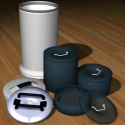PEP-12 (Personal Electronics Protector)

Our latest product is a Personal Electronics Protector faraday cage. On September 5th of 2014, I re-submitted paperwork to the Patent Office for the standard model and two others after minor design changes. So, Patent Pending.
As a Mechanical Engineer, working with several Electrical Engineers, I came up with this slick looking design that offers the best protection from natural and man-made electro-magnetic pulses (EMP). Not only will this cage stop E1, E2 and E3 particle/gamma waves, but also stops device easedropping, moderate impacts, fire AND water damage!
The standard model is called the PEP-12. It is 25 inches tall and 12 inches inside diameter. What this product consists of is a sealing 12 gauge metal shell, latching lid, anti-static shielded poly-styrene liner, three stacking component tubs and a locking cover plate. The ABS plastic base has rubber feet to protect floors and a special plug for grounding to a standard wall outlet. Several options are being worked on and include domed top, pedistal top to disguise the unit as a stand, electronic locking cover plate, floor mounting plate and stainless steel component tubs.

3D Printing

Soon, Krown Products Ltd. will be offering 3D printing services Whether you need a prototype created, replacement part or figurine statue we'll be able to help. 3D printing is quickly becoming the latest craze with CAD design engineers.
A 3D printer cannot make any object on demand like the "Star Trek" replicators of science fiction. But a growing array of 3D printing machines has already begun to revolutionize the business of making things in the real world.
3D printers work by following a computer's digital instructions to "print" an object using materials such as plastic, ceramics and metal. The printing process involves building up an object one layer at a time until it's complete. For instance, some 3D printers squirt out a stream of heated, semi-liquid plastic that solidifies as the printer's head moves around to create the outline of each layer within the object.
The instructions used by 3D printers often take the form of computer-aided design (CAD) files — digital blueprints for making different objects. That means a person can design an object on their computer using 3D modeling software, hook the computer up to a 3D printer, and then watch the 3D printer build the object right before his or her eyes.

 You won't find a PEP at Wally World!
You won't find a PEP at Wally World!
